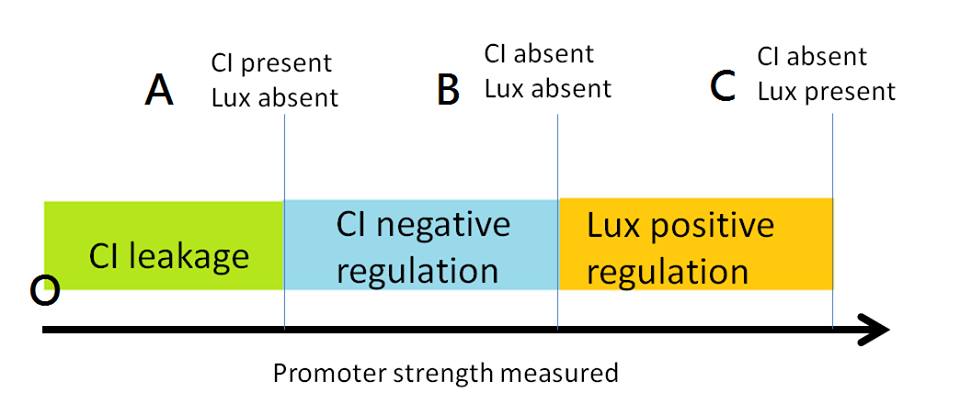To learn about this mechanism, click here2.
From 2013.igem.org
(Created page with "== Model highlight 2:How capsule concentration influences Bee.coli survival rate == We do this model in order to know whether capsules ingested by bees could be effective enough...") |
|||
| (4 intermediate revisions not shown) | |||
| Line 1: | Line 1: | ||
| - | + | {{:Team:NYMU-Taipei/Header}} | |
| - | |||
| - | |||
| - | The | + | The synergistic effect of Lux and CI to pLux/CI is complicated and is not characterized in quantity yet. To simplify the pLux/CI hybrid promoter’s behavior in our circuit regulation model and at the same time enables wet lab to characterize it experimentally, we a module showing the relationships between CI negative regulation and Lux-AHL complex positive regulation. |
| - | + | In our regulation process of our project we mainly face three scene: CI present while Lux absent, CI and Lux both absent, and CI absent while Lux present. | |
| + | Promoter strength shown in the picture are subtracted to form differences in promoter strength OA, AB, BC. OA represent the leaky effect of CI regulation; AB represent the promoter strength regulated by CI negatively; BC represent the promoter strength regulated by AHL-Lux complex positively. Then they’re quantified by Hill effect expression [[(to learn more about the ODE regarding pLux/CI promoter, click here)]] | ||
| - | + | This simplification combines wet lab and dry lab’s effort that we can describe the promoter’s effect in ODEs for the model in dry lab while wet lab can verify it and provide parameters by doing experiment. | |
| - | + | ||
| - | + | ||
| - | + | ||
| - | + | ||
| - | [[Image: | + | [[Image:NYMU_hill property.png|center]] |
| - | + | ||
| + | This picture gives a concept of our model for pLux/CI behavior. The promoter strength of pLux/CI when CI present while Lux absent, CI and Lux both absent, and CI absent while Lux present are measured respectively. | ||
| + | |||
| + | |||
| + | {{:Team:NYMU-Taipei/Footer}} | ||
Latest revision as of 03:59, 28 October 2013


The synergistic effect of Lux and CI to pLux/CI is complicated and is not characterized in quantity yet. To simplify the pLux/CI hybrid promoter’s behavior in our circuit regulation model and at the same time enables wet lab to characterize it experimentally, we a module showing the relationships between CI negative regulation and Lux-AHL complex positive regulation.
In our regulation process of our project we mainly face three scene: CI present while Lux absent, CI and Lux both absent, and CI absent while Lux present. Promoter strength shown in the picture are subtracted to form differences in promoter strength OA, AB, BC. OA represent the leaky effect of CI regulation; AB represent the promoter strength regulated by CI negatively; BC represent the promoter strength regulated by AHL-Lux complex positively. Then they’re quantified by Hill effect expression (to learn more about the ODE regarding pLux/CI promoter, click here)
This simplification combines wet lab and dry lab’s effort that we can describe the promoter’s effect in ODEs for the model in dry lab while wet lab can verify it and provide parameters by doing experiment.
This picture gives a concept of our model for pLux/CI behavior. The promoter strength of pLux/CI when CI present while Lux absent, CI and Lux both absent, and CI absent while Lux present are measured respectively.
 "
"









